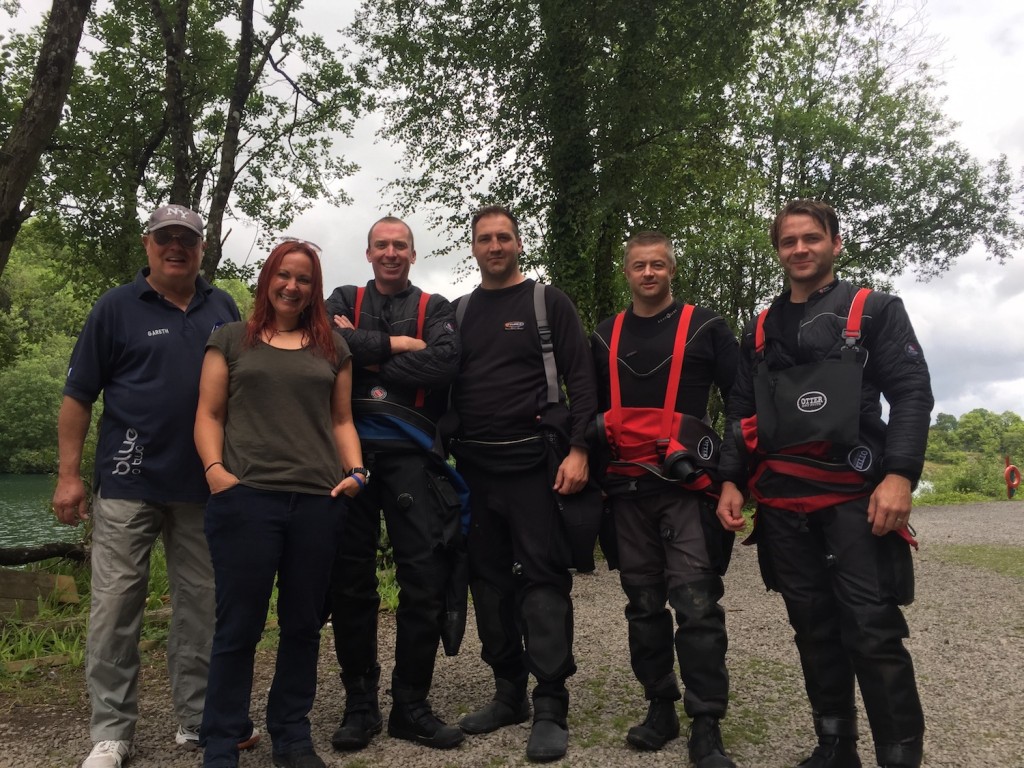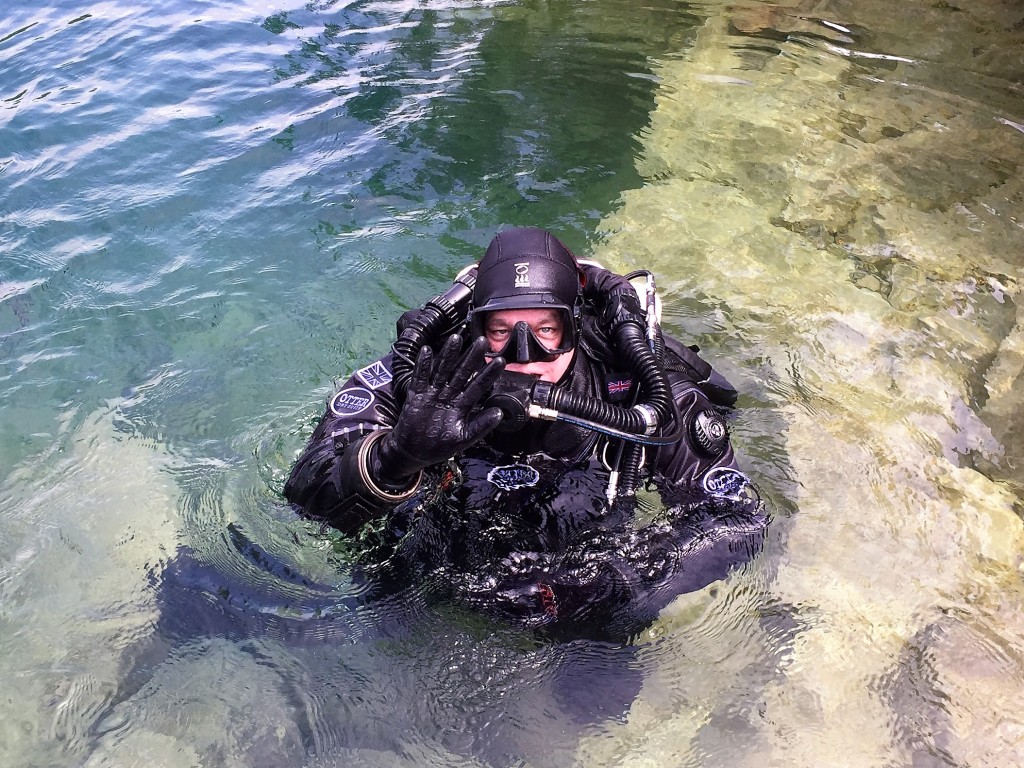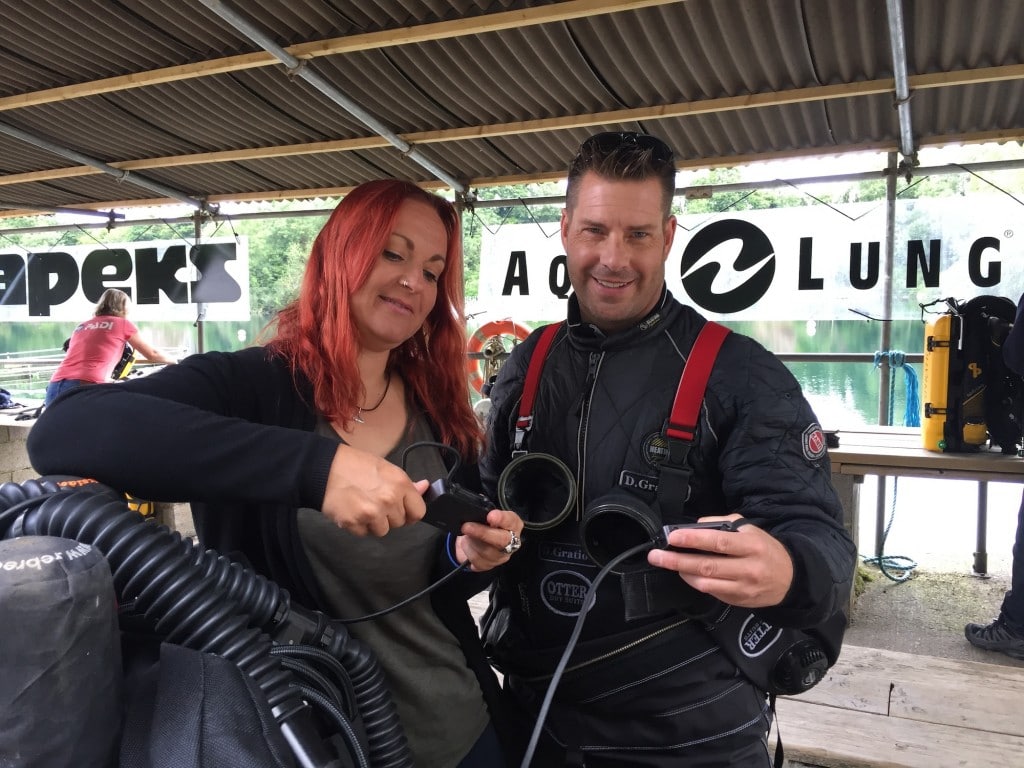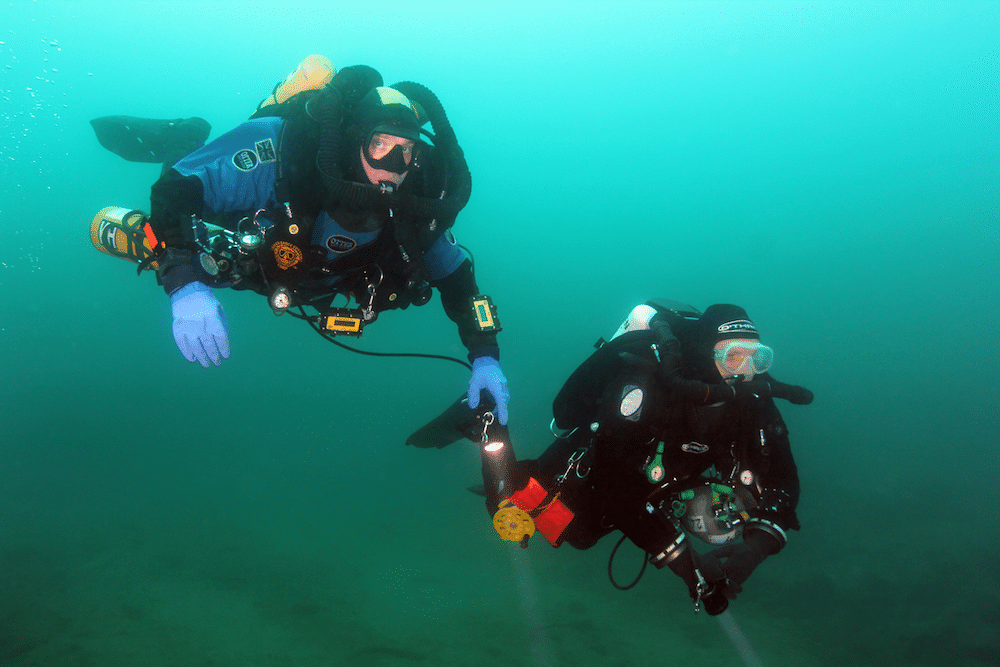Gear Reviews
Suck it and See! Cath Bates reviews the Vobster CCR try-dive event

Vobster Quay hosted a multi-unit CCR try-dive event on the 3rd and 4th July. This year TekCamp took a break but the Vobster team ran a smaller, more intimate two day educational affair focusing on eight rebreathers. With just 10 students, five instructors and five safety divers attending, the surface waters of Vobster remained bubble-free as we were taken on a journey of silent exploration……
I was one of only two attendees who had done any substantial rebreather diving. I chose to attend as my 80 hours have only ever been on the one unit and I was a bit rusty after a year of diving just open circuit. I had never tried back-mounted counter lungs or used an axial scrubber. Electronics have also moved on somewhat since my 2009 Inner Space Systems Megalodon saw the light of day.
I completed my course in the warm, clear waters of the Red Sea in early 2014 whilst working as an instructor. I swore I would never need to dive open circuit again! After racking up as many hours as my days off and holidays would allow, I eventually returned to the life of a land mammal in October 2015. My Gear Gulper now sports the television (as buying furniture comes second to diving holidays of course) and the money I once spent on Sofnolime and cells now goes on my newest passion – photography. BUT I never voluntarily gave CCR diving up, so this event was a must for me.

Cath with Team Kieran
At TekCamp, Site Manager Tim Clements runs a well-oiled machine. This event was no different. On arrival, the instructors were presented with their student lists and expected run-times for each day. Safety was optimum and briefings consisted of a signal review, emergency recall procedures, what to do in the event of a missing team member etc. Paperwork was thorough and a highly proficient team of safety divers supported the instruction team. They included Ian France of Ian France Technical, Toni Norton from Purple Turtle Diving and Oliver Van Overbeek of Diving Matrix (among others). During every dive, the instruction team reminded us at regular intervals to check our PO2.

Paul Toomer
On offer for the event were the AP Inspiration, JJ, SF2, Triton, Liberty, RedBare, RedHead and Poseidon Se7en. I had picked the JJ and RedBare as my 2 top choices with the Liberty as my 3rd and Inspiration as my 4th. In that order, I got to try them out. My instructors were Kieran Hatton (Diving In Depth), Paul Toomer (RAID) and Dave Gration (Rebreatherpro Training). Vikki Batten – PADI’s Director of Rebreather Technologies and Martin Robson (IANTD ITT and ITD for the National Association of Cave Diving) were also on hand as instructors at the event.

Vikki Batten’s team
Other than the usual weighting issues when switching between units, I had a very comfortable couple of days. A gurgly loop here and there or an oversized harness didn’t spoil my experience in any way. None of us had long waiting times as each session comprised of just 2 students. Each student was in the water alone with both the instructor AND safety diver for a minimum of 40 minutes. You certainly couldn’t say it wasn’t value for money.
Bubble checks and bail-out drills were standard on each dive, to ensure that if we weren’t comfortable we could switch back to familiar old open circuit. We practiced maintaining minimum loop volume and also manual add to bump up the partial pressure of oxygen. No certifications were being awarded and as such, there was no peer pressure to perform or to perform better than others. You had enough time to have a feel for each unit, get your buoyancy right and enjoy the silence.

Photo Credit: James Harris
Below is some info and my opinion on each unit I tried:
JJ CCR – www.jj-ccr.com
The JJ was the brainchild of instructor Jan Jorgensen and designer and engineer Jan Petersen (hence the name). The UK’s Dave Thompson (previously a stalwart of AP Diving’s Inspiration) designed the back-mounted 8 litre counter lungs. It is still handcrafted in Denmark today and is used by the Scandinavian military as their unit of choice. The website calls it “the 4 x 4 of the Rebreather community….. built to handle harsh environments and demanding adventures”.
Whilst made abroad, the JJ is well looked after by UK Service Centres (Kieran and Narked at 90 included).
The 2014 CE-Edition has a Shearwater Petrel computer, digital Heads Up Display (HUD) which has its own electronics and power supply and a solenoid (oxygen injection system) with extremely low power consumption. The JJ’s canister is made from hard anodized alluminium and the lid machined from Delrin. It can support 12 litre cylinders for more technical requirements as well as the usual 3 litre size.

Kieran Hatton
On the JJ CCR website there are 12 UK instructors listed. One of those is the very patient, no-nonsense Kieran Hatton who has 20 years of experience in technical diving.
I found the JJ delivered a very smooth breathe and the Diver Surface valve (DSV) lever was a piece of cake to operate with one hand. As I am familiar with Shearwater computers, I felt happy seeing my cell readings, set point and other dive information on the ample screen. My trim was slightly bottom-heavy but of course if this was my own unit, I would be able to reposition the weights in optimum positions to avoid that. Kieran mentioned this was because the cylinder valves are quite low on the unit in addition to the weight of the stand.
My first experience with back-mounted counter lungs was rather pleasant – it didn’t feel in any way cluttered around my chest. The single-piece webbing harness was also comfortable. I wasn’t happy however with the gauges being behind me. If this was my unit I would endeavor to have them routed in front. The non-obtrusive HUD communicated the partial pressure of oxygen in my loop with flashing LEDs and the manual adds were easy to locate and use while diving.
For assembly, the cylinders are mounted using standard cam bands which is minimal faff and the sprung axial scrubber canister fits into the can like closing a Jack in the Box! The lid clicks nicely into place and is removed by pushing the button back in. Kieran’s only criticism was that the sloping pit of the can (above the lid) has a tendency to trap debris when diving in wrecks. This means you have to be super careful when removing the lid to ensure the o-rings don’t get damaged or covered in rust. He had designed a neoprene cover like the ones that fit over a camera dome port to avoid this problem. Regulators are supplied by Apeks and the gold contacts attached to the cells are more effective than copper.
I did find the JJ quite heavy for my 5 foot 6 frame.
RedBare – www.vmsrebreathers.com
Whereas the JJ CCR is recommended for “a skilled diver fully aware of the Pros and Cons of technical rebreathers”, the lipstick-coloured RedBare promotes itself for both the extreme explorer AND the Sport Diver. Evolved from the Sentinel RedHead, VMS (Vobster Marine Systems) upgraded the unit to enhance the Work of Breathing (WOB), to make it more travel-friendly (it is 18.4Kg travel-ready with loop and electronics removed) and also to make servicing easier in the field. I certainly found this the lightest unit to put on and thought nothing of walking around in it.
Martin Stanton’s background in electronics means that he has pretty much thought of everything. The electronics are totally “potted” and include:
- Custom PO2 sampling to 50 milliseconds
- CO2 monitor using infa-red technology
- A second trimix CCR computer
- Temperature stick for the scrubber
- A Metabolic Rate Counter (MRC) indicating remaining scrubber time based on the diver’s metabolic activity
- A second “buddy” HUD on top of the unit
- Waterproof, modular plug and play cabling
- Rechargeable batteries

RedBare pre-breathe
VMS state that there are 13 RedBare instructors in the UK and RAID’s Paul Toomer is one of them. His briefing was engaging and he truly loves to dive the RedBare. Paul’s enthusiasm is always infectious but you know when he REALLY believes is something. Taking into consideration the list above and the Apeks first stages, this unit is first and foremost great value for money.
Securing the 2.25kg scrubber stack was genius! It sprung into place effortlessly. The air gap surrounding it has been designed to improve sensor accuracy (fewer moisture problems) plus scrubber function and is the only CCR tested to have a 4-hour scrubber duration. All unit-prompted checks are completed by viewing the handset and as the pre-breathe is timed, you cannot dive the unit until it is happy the scrubber is nice and warm.

RedBare
I managed to get into the RedBare without the standard rebreather shimmy and grimace, as the harness is adjustable. The chunky DSV was a breeze to turn at the surface and following a quick weight check, I descended. As if someone flicked a switch I had demonstration-quality horizontal trim! This was helped by a combination of the back-mounted counter lungs, petite low wing and weight of the Delrin. The WOB WAS very low. I understand that the large-bore breathing hoses and counter lung positioning (to the sides of the backplate) contribute to this.
Initially I was slightly unnerved that there were no analog gauges but this is 2017: everything you need to know about your unit during a dive is given to you by the electronics, backed up by an independent secondary computer. I personally didn’t find the handsets the clearest from today. I had to squint from time to time to read the bottom right of the OLED handset which sat on my left arm, but I have been putting off that eye test for a while now…..The HUD however was idiot-proof with the comforting green light indicating stable PO2, good CO2, dil/O2 pressures OK and Thermal Profile Monitor warm plus all electronics functioning tickety-boo. I am informed new, clearer handset displays are in development.
A bit of leftover drool was moving around in the loop and as a novice on the RedBare, I didn’t know how to shift it so the silence was broken toward the end of my dive. Back on the surface however, Martin showed me the method for draining the loop. He waited patiently for every try-diver to exit the water noting their comments. With this attention to detail and VMS being a UK manufacturer, you can guarantee top-notch support services as a RedBare owner.
On Monday night Martin gave an epic talk about the process of getting CE for the RedBare which included hydrostatic WOB tests and CO2 breakthrough tests.
Liberty CCR – www.ccrliberty.com
I was excited about diving the Liberty for two reasons. The first was that last summer I listened to Eduardo Pavia talk about his recent Britannic Expedition and was keen to dive it. The second was that it appeared to be the most similar unit to the Megalodon. And just like when one is in a broken-down love affair, I wanted to stop hurting a little.

Checking handsets of Liberty
The Liberty is an expedition rebreather. It calls itself “Fault-tolerant” which means that no single malfunction in the electronic system can cause a breakdown of the whole apparatus, including torn cables. The “It’s Up to You” slogan that they have adopted means that it can still be dived if there is a malfunction warning. However, in the wrong hands, you could argue this feature can be fatal.
All components of the Liberty CCR are specially manufactured in the Czech Republic and it is one entire unit. By that, I mean that you cannot change out the wing supplied with YOUR favourite wing or swap backplates over. Even the first stages of the Apeks supplied regs are affixed TO the backplate and therefore there are no cylinder rails or locks. This gives it a very solid appearance and nothing -by any means- wobbles or fits badly on the Liberty!
The Liberty’s electronics are vast. There are 2 control units, each with their own battery, 2 CO2 sensors, depth and atmospheric pressure sensors and a helium concentration sensor. For each control unit, there is a separate solenoid that mutually shares data. For the novice, this would be a lot of maintenance and cost and features that may remain redundant. Despite these extras, the unit cost is not extortionate.
Dave Gration (IART, IANTD, TDI and PADI instructor) briefed us on the Liberty. He is one of just 3 UK instructors. He has an unpretentious, easy to follow instructor voice and he explained this complicated racing car of a CCR in the most simple terms. I liked the look of the 2 control units. The secondary controller has an option of putting all the vital information (set point, cell readings and depth/time for example) in large bold digits. Unfortunately, during the dive this controller periodically switched itself off. Easy enough to reactivate with the push of a button though.

Dave Gration with Cath
The pilot-style harness was a doddle to get in and out of and felt like I was wearing a parachute! The metal quick-release would be a god send in a rescue situation. In addition to this the weight pouches have rip cords for emergency jettison!

Pre-breathing the Liberty
I was unsure about the horseshoe wing thinking that the migrating air within it would tilt my trim bottom heavy again, but the front mounted counter lungs seemed to balance everything out. After diving 2 units with the lungs behind me I was expecting an odd dive but it was like falling back into the arms of an old lover (though quieter and less-complicated!) All the manual add controls, ADV and gauges were in the same familiar place as my Meg and the scrubber type is also a radial (a design where breathing gases move from the middle to the outside of the scrubber).
The HUD was a tad annoying, always in my field of view despite the ability to slide it further across but the blinking LEDs were small enough to reduce the annoyance. There was also a secondary buddy display on top of the lid for my safety diver to know that the measured partial pressure of oxygen in the loop was correct.
The Liberty professes to have one of the world’s best WOB. I certainly felt like this was the best of the 3 units I had tried so far. It was also the quietest and at one point I even closed my eyes to enjoy the silence further. I was a little bit in love……
Inspiration – www.apdiving.com
 The AP website has by far the most comprehensive information for anybody considering getting into rebreathers. Whereas some of the other units I dived this week have 12 UK instructors, the Inspiration has 12 AGENCIES for you to choose your instructor from!
The AP website has by far the most comprehensive information for anybody considering getting into rebreathers. Whereas some of the other units I dived this week have 12 UK instructors, the Inspiration has 12 AGENCIES for you to choose your instructor from!
AP Diving has over 45 years of manufacture experience, has been providing equipment for the military since 1981 and has been making the Inspiration since 1997. 95% of the parts for these units are made and in the UK and like the RedBare, customer support is always on hand.
While I had now dived three of the coolest CCRs on the market, there was a part of me that still felt I should try the Inspo. It is after all the world’s most widely-used rebreather. Much in the same way we all love a glass of Bollinger, there really is nothing to be ashamed of buying a bottle of supermarket-own champagne. Had I not had access to a Megalodon while I was working in Egypt I am sure I would have learnt on an Inspiration.
When purchasing an Inspiration, you are buying a custom-built unit. You can choose from:
- 3 different models
- 3 box sizes
- 5 harness sizes
- 2 wing sizes
- 2 cylinder sizes
- 2 scrubber durations
- Front or back mounted counter lungs
- Deco options on the electronics
I was diving an XPD but all the Inspos have some pretty nifty features these days: Rechargable batteries are now standard, you get a fibre-optic no-flood HUD, dual power supplies, 2 Power sources and 2 controllers (which although not unique, is quite rare these days) LCD colour displays and Buhlmann (with Gradient Factors) software can be supplied on presentation of appropriate Nitrox and Trimix certification.
The loop hose length and harness I used at this event were not the optimum ones for my size but I didn’t have a bad dive by any means. I generally dive with a single piece webbing harness, backplate and wing. This style of chunky wing and weight harness is not normally my cup of tea but it felt comfortable and padded (made from tough Dupont Codura). The unit I was using had back-mounted counter lungs (available since 2012) which left my chest area clutter free and I found the manual add controls easy to find simply by feel. Kieran mentioned that I would have been able to see these better had the breathing hoses been custom cut shorter for my torso length or if I was diving the smaller Inspiration Evo. I wasn’t entirely comfortable with the position of the D-rings for my bail-out cylinder but this was not a major worry.
At the surface however, I felt the counter lungs were crushing under the bulky weight of the unit and therefore it was quite difficult to breathe comfortably while putting on my fins. Kieran held up the harness to reduce the pressure which helped. Underwater my trim was nicely horizontal and I didn’t have this issue in the slightest.
The DSV on the Inspiration is more complex than the other units. After diving three units where the DSV was operational with one hand, I found this one frustrating. The mouthpiece also felt heavier in my mouth but this may have felt different had the hoses been custom length. The “no distractions” HUD kept its 2 green lights signaling ok for my entire dive but it was so non-distracting that I started to forget it was there and used the LCD displays to keep checking my PO2 instead. I heard a low battery warning on another unit underwater and believe me, the audible alarms are ample!
Saying that, I enjoyed diving it and could see this would be an easy machine to take your first CCR steps in. Safety diver Ian likened it to a Ford Mondeo meaning that it is reliable, affordable and unpretentious and Kieran – who’s dad’s unit I was diving – said that it ‘does exactly what it says on the tin.’
Along with the Poseidon, PADI offer courses on the Inspiration for both their recreational divers and for the TecRec courses. I can’t find one reason why this shouldn’t be the unit of choice for anyone thinking of continuing up the PADI ladder.
This event was thoroughly enjoyable and a bit more intense than simple “try”-dives. We watched the units get built, taken apart and cleaned and scrubber stacks filled. We were shown the delicate working parts and given an idea of the cost of spares. On leaving, I would say a novice would have a pretty good idea of which unit they would like to get certified on and what a rebreather would cost in both time and money to maintain as a user. At no point were we given the hard sell about any unit, training agency or course. The only bias was the amount of one particular Danish unit being dived by the training team. I guess that will have swung a couple of opinions at least!

Photo Credit: James Neal
Top marks to Amy, Martin, Tim and their great team of staff at Vobster for another memorable and well-run event. Massive thanks to Kieran Hatton, Dave Gration, Paul Toomer and Tim Clements for their technical assistance in checking my facts in this feature and for donating photographs!
Useful Links
IANTD – www.iantd.uk.com
PADI – www.tecrec.padi.com
RAID – www.diveraiduk.com
TDI – www.tdisdi.com
Diving Matrix – www.divingmatrix.co.uk
Diving in Depth – www.divingindepth.co.uk
Rebreather-pro Training – www.rebreatherpro-training.com
Martin Robson – www.eau2.com
Vobster – www.vobster.com
Gear Reviews
Gear Review: BARE Eclipse Hooded Rashguard (Watch Video)

In a video recorded exclusively for Scubaverse, Jeff Goodman reviews the new Hooded Rashguard from BARE.
Find out more about BARE products at www.baresports.com.
Sea & Sea is the home of BARE and other Huish Outdoors diving brands in the UK.
Gear Reviews
Gear Review: Fog-X anti-fogging insert for dive masks

In a video exclusively produced for Scubaverse.com, Jeff Goodman reviews Fog-X, the only long lasting anti-fog insert for dive masks that you apply once and forget.
Find out more about Fog-X products at fog-x.myshopify.com.
-

 News2 months ago
News2 months agoIconic SS United States to become the World’s Largest Artificial Reef
-

 News3 months ago
News3 months agoBook Review – 52 Assignments: Underwater Photography
-

 Gear News3 months ago
Gear News3 months agoDYNAMICNORD – New German diving brand enters the British market
-

 News3 months ago
News3 months agoExploring Cenote El Pit: A Diver’s Dream
-

 Gear News3 months ago
Gear News3 months agoTry BARE drysuits (and maybe even win one!) this Friday with Sea & Sea at North West Dive Fest
-

 Marine Life & Conservation3 months ago
Marine Life & Conservation3 months agoBook Review: Coral Triangle Cameos
-

 Blogs2 months ago
Blogs2 months agoDive the Egyptian Red Sea this Autumn with Regaldive
-

 News3 months ago
News3 months ago2024 Ocean Art Underwater Photo Competition Announced















